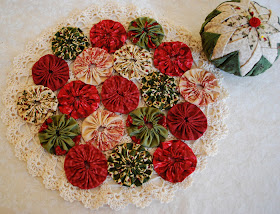Ten Minutes of Tranquility
On a cold and frosty morning the Lady-of-the-house ventured outside. The temperature was in the teens. The day was dawning pink behind the trees. It was a week before Christmas and although there was no need for last minute shopping, the Lady-of-the-House had her nerves a bit on edge. Nature, however, has its calming affects and that morning it was a treat for the senses. The air was clean, the sky clear. With muffled steps on the softest of snow she meandered in a peaceful oasis of quiet. Only the faintest tweet of a bird, half a mile away, could be heard. No breeze moved in the branches. All was still and frozen.
The light snowfall dusted a pot of herbs that the Lady-of-the-House was remiss in planting in the ground for over-wintering. The candytuft next to the oregano looked as if it was sprinkled with powdered sugar. A set of tiny paw prints, at the side door, nearly went unnoticed had it not been that the Lady-of-the-House is versed in Beatrix Potter.
Stinging fingers beneath their gloves told the Lady-of-the-House it was time to go inside. Left on her desk was Parents and Children. The middle of chapter 17 was bookmarked. It must have been its message on sensations that had renewed her desire for an early morning meandering. The chilly walk took only ten minutes but was immeasurably refreshing to the soul - ten minutes of tranquility to “tarry” alone in the garden with God and His creation.
Education by Observation
Observation by way of the senses is what Miss Charlotte Mason talks about in chapter 17 of Parents and Children. (“We” refers to we who teach.)
She says,
"For the first five or six years of his life everything, especially everything in action, is an object of intelligent curiosity for the child – the street or the field is a panorama of delight, the shepherd’s dog, the baker’s cart, the man with the barrow, are full of vivid interest. He has a thousand questions to ask, he wants to know about everything; he has in fact, an inordinate appetite for knowledge. We soon cure all that: we occupy him with books instead of things; we evoke other desires instead of the desire to know; and we succeed in bringing up an unobservant man [ . . . or woman] who discerns no difference between an elm, a poplar, or a lime tree, and misses very much of the joy of living.”
Best Learned Out of School
Have you ever wondered why A Charlotte Mason Companion includes a chapter on the senses? One book reviewer who found Companion interesting also warned that some of its pages have nothing to do with education. That’s fine. Everyone is entitled to an opinion. The reviewer might be right. Yet she declines to identify the superfluous.
This got the Lady-of-the-House thinking. Perhaps if a more schoolish title to the chapter were attributed to it, such as, “Foundations of an Education by Observation,” this would satisfy utilitarian expectations. She prefers, “Summer Senses for Country Folk.” It is a winsome title for a winsome chapter that really doesn’t have anything to do with school at all. And yet, it has everything to do with what Miss Mason advised in Parents and Children because it encourages a child to observe (learn about) his world through the fine-tuning of his senses. It encourages an education by “books and things.”
Indoor Guessing Games
In her chapter Miss Mason recommends indoor games for training young children in the use of their senses. The Lady-of-the-House chose a “rainy day” – actually a gray cloudy week in mid-winter - to play these games with her children (ages 4 to 10). They require a collection of household items and the use of a simple blindfold. The children can just close their eyes but a blindfold accentuates reliance on their other senses.
One by one, items were placed in the hands of her willing participants to touch and weigh. Another day items to smell, the next day things to taste, were for guessing. Yet another day was a game to discriminate sound. These short winter games accompanied more bookish lessons and were met with a few giggles.
Here are some examples. Many others will suggest themselves to you.
Feel: Hairbrush, basket, ball of yarn
Taste: lemon, peanut, carrot
Smell: crushed thyme, grated ginger, cinnamon stick
Weight, Size, Shape: coins, rubber band, large bowl
Sound: water pouring, sandpapering, the refrigerator opening
New Vocabulary for Narrating
Children, while narrating their observations, will welcome new vocabulary offered by the teacher. By supplying new words she helps them find the words for describing texture, shape, weight, fragrance, sound, etc. This is training in exactitude.
Some years later, the same descriptive vocabulary is likely to be called upon by an older student when polishing his writing. And here we see that anything really educational will make its way eventually into a child’s store of knowledge or skill as rain makes its way to the sea.
Sensory Language
The Lady-of-the-House has been looking for a way to make a graceful entrance in mentioning her book, Story Starters. Today’s post beckons her to do so because Story Starters provides oodles of opportunities in using sensory language – language of the five senses. At first the student is encouraged to write freely, with gusto, with zest, or more abandon than he is used to. This is the most important aspect of writing, and the main purpose of the story starters. Afterwards the student is required to go back over his writing to do some polishing – to polish it until it shines. He will want his story to read as vividly as it is in his imagination. Using descriptive vocabulary will deliver particular details about his characters, setting, and actions. Therefore, he is guided to use language of the five senses. Lessons that follow are “vivid verbs”, “artful adjective” and “advantageous adverbs”, etc. but the use of sensory language heads the way.
Charlotte Mason ends her chapter with this:
“No doubt the best and happiest exercises of the senses springs out of a loving familiarity of the world of nature, but the sorts of gymnastics [games for the mind] indicated render the perceptions more acute, and are greatly enjoyed by children.”
Discussion is invited.
Happy New Year
Karen Andreola
Karen Andreola






















































